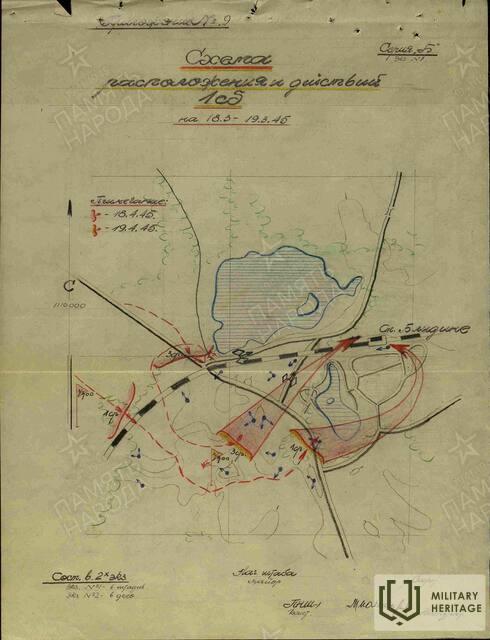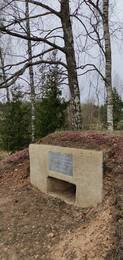Sovietų Sąjungos didvyrio žygdarbis - 8-ojo Estijos korpuso leitenantas Jakobas Kunderis
Žuvusio 8-ojo Raudonosios armijos Estijos šaulių korpuso karininko Jakobo Kunderio didvyriški veiksmai užtikrino sėkmingą bataliono puolimą, tačiau jis pats žuvo, o jo žūties vietoje Jakobui Kunderiui pastatytas paminklas, o Tuškio brolių kapinėse – paminklas.
„Leitenantui Jakobui Kunderiui įteiktas Sovietų Sąjungos didvyrio vardas“
1945 m. kovo 17 d. 1-oji kuopa gavo bataliono vado įsakymą užimti „Kazarmą“ ir Blīdenės stotį. Kovo 18 d. naktį draugas Kundersas įsiveržė į „Kazarmą“, kurį priešas buvo pavertęs įtvirtinta vieta, pastatų langus paversdamas ambrazūromis. Sumaniai vadovaudamas, draugas Kundersas užėmė „Kazarmą“, taip užimdamas dalį priešo įtvirtinimų. Likęs „Kazarme“, laikinai ginantis, draugas Kundersas naudojosi priešo pastatytu įtvirtintu atramos punktu.
1945 m. kovo 18 d. rytą batalionas pradėjo puolimą priešo įtvirtintos tvirtovės centre. Draugas Kundersas su savo būriu pasitraukė į kairįjį flangą. Priekyje būrio priešas atidengė ugnį iš apkaso, bandydamas flangine ugnimi pargriauti puolančias kareivių grandines. Draugas Kundersas, pamatęs grėsmę, greitai pribėgo prie apkaso ir metė granatą. Granata sprogo netoli apkaso ambrazūros. Antroji granata sprogo apkaso viduje. Kulkosvaidis nutilo, bet tuoj pat atnaujino ugnį. Draugui Kundersui pritrūko granatų ir jis pradėjo šaudyti į ambrazūrą pistoletu. Draugas Kundersas buvo sunkiai sužeistas, tačiau atsižvelgdamas į situaciją, kai kulkosvaidžio ugnis galėjo nuslopinti ataką, jis priartėjo prie apkaso ir savo kūnu uždengė ambrazūrą. Tokiu būdu draugas Kundersas užtikrino sėkmingą bataliono ataką. Šiuo metu draugas Kundersas vėl buvo sužeistas ir mirė.
Greito puolimo metu batalionas užėmė priešo įtvirtintą aukštumą Blīdenės stoties ir Pilsblīdenės dvaro sankryžoje.
1945 m. kovo 31 d.
"300-ojo šaulių pulko vadas pulkininkas leitenantas Paulsas."
Istorinis žemėlapis iš „Žmonių atminties“: memory-people.ru
Susijusios vietos
Kunderos piliulės dėžutė
Žuvusio Raudonosios armijos 8-ojo Estijos šaulių korpuso karininko Jakobo Kunderos (ištrinta) memorialas yra kapinėse, 200 metrų į pietvakarius nuo Blidenės-Remtės kelio ir Rygos-Liepojos geležinkelio mazgo.
1945 m. kovo 17 d. prasidėjo paskutinis Raudonosios armijos puolimo bandymas Kuržemėje. Estijos 8-ojo šaulių korpuso 7-osios Estijos šaulių divizijos užduotis buvo pasiekti Rygos-Liepojos geležinkelio liniją į vakarus nuo Blidenės stoties ir užtikrinti 3-iojo gvardijos mechanizuotojo korpuso ataką Gaikų kryptimi. Iki kovo 17 d. vakaro 354-asis šaulių pulkas per mišką pasiekė geležinkelį į pietus nuo Kaulačių dvaro ir tęsė atakas šiaurės vakarų kryptimi. Kadangi 130-ojo Latvijos šaulių korpuso atakos Pilsblidenės dvaro link nebuvo tokios sėkmingos, Estijos 300-ajam šaulių pulkui buvo pavesta kovo 18 d. naktį pulti į vakarus ir pietvakarius, kirsti geležinkelį iš šiaurės ir užimti Blidenės stotį.
Blīdenės stoties apylinkėse jau 1940 m. pavasarį Latvijos armija buvo pastatijusi laikinas kareivines ir sandėlius, kurie buvo pavadinti „kareivinėmis“. 1945 m. Vokietijos armija stoties apylinkėse pastatė keletą požeminių slėptuvių (bunkerių), kuriose žiemą galėjo gyventi kareiviai. Nebuvo jokių įtvirtinimų, nei išmuštų, nei duotų, ir labiausiai tikėtina, kad leitenantas Jakobas Kunderis žuvo artimos kovos metu viename iš bunkerių.
Iškart po mūšio Jakobas Kunderis buvo palaidotas dabartinėse Pilsblidenės kapinėse, o vėliau perlaidotas Tuškų brolių kapinėse.
Šiandien galima pamatyti simbolinę sovietinę gelžbetoninės kulkosvaidžio ambrazūros reprodukciją su atminimo lenta.







